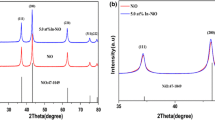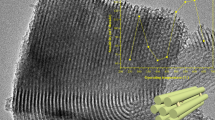Abstract
Mesoporous Cr or Pt-doped WO3 thin films to be employed as ammonia gas sensors were prepared by a fast one-step sol–gel procedure, based on the use of triblock copolymer as templating agent. The obtained films were constituted by aggregates of interconnected WO3 nanocrystals (20–50 nm) separated by mesopores with dimensions ranging between 2 and 15 nm. The doping metals, Pt and Cr, resulted differently hosted in the WO3 mesoporous matrix. Chromium is homogeneously dispersed in the oxide matrix, mainly as Cr(III) and Cr(V) centers, as revealed by EPR spectroscopy; instead platinum segregated as Pt (0) nanoparticles (4 nm) mainly included inside the WO3 nanocrystals. The semiconductor layers containing Pt nanoclusters revealed, upon exposure to NH3, remarkable electrical responses, much higher than Cr-doped and undoped layers, particularly at low ammonia concentration (6.2 ppm). This behavior was attributed to the presence of Pt nanoparticles segregated inside the semiconductor matrix, which act as catalysts of the N–H bond cleavage, decreasing the activation barrier in the ammonia dissociation. The role of the mesoporous structure in influencing the chemisorption and the gas diffusion in the WO3 matrix appeared less decisive than the electronic differences between the two examined doping metals. The overall results suggest that a careful combination between mesoporous architecture and metal doping can really promote the electrical response of WO3 toward ammonia.








Similar content being viewed by others
References
Göpel W, Hesse J, Zemel JN (1991) Sensors. A comprehensive survey, vol 2: Chemical and biochemical sensors (Parts 1 and 2). VCH Weinheim, New York
Barsan SN, Bauer M, Weimar U (2001) Sens Actuators B 73:1–26
Göpel W, Hesse J, Zemel JN, Meixner H, Jones R (1995) Sensors. A comprehensive survey, vol 8. VCH Weinheim, New York
Moseley PT, Tofield BC (1987) Solid- state gas sensors. Hilger, Bristol/Philadelphia
Sberveglieri G (1992) Gas sensors: principles, operation and developments. Kluwer, Boston
Mandelis A, Christofides C (1993) Physics, chemistry and technology of solid state gas sensor devices. Wiley, New York
Cui Y, Wie Q, Park H, Lieber CM (2001) Science 293:1289–1292
Xia Y, Yang P, Sun Y, Wu Y, Mayers B, Gates B, Yin Y, Kim F, Yan H (2003) Adv Mater 15:353–389
Lee JH (2009) Sens Actuators B 140:319–336
Scott RWJ, Yang SM, Coombs N, Williams DE, Ozin GA (2003) Adv Funct Mater 13:225–231
Acciarri M, Barberini R, Canevali C, Mari CM, Mattoni M, Morazzoni F, Nodari L, Polizzi S, Ruffo R, Russo U, Sala M, Scotti R (2005) Chem Mater 17:6167–6171
Sasahara K, Hyodo T, Shimizu Y, Egashira M (2004) J Eur Ceram Soc 24:1961–1967
Wang H, Liang J, Fan H, Xi B, Zhang M, Xiong S, Zhu Y, Qian Y (2008) J Solid State Chem 181:122–129
Firooz AA, Mahjoub AR, Khodadadi AA (2009) Sens Actuators B 141:89–96
D’Arienzo M, Armelao L, Cacciamani A, Mari CM, Polizzi S, Ruffo R, Scotti R, Testino A, Wahba L, Morazzoni F (2010) Chem Mater 22:4083–4089
Choi WK, Song SK, Cho JS, Yoon YS, Choi D, Jung HJ, Koh SK (1997) Sens Actuators B 40:21–27
Canevali C, Chiodini C, Morazzoni F, Scotti R, Bianchi CL (1997) J Mater Chem 7:997–1002
Canevali C, Mari CM, Mattoni M, Morazzoni F, Nodari L, Ruffo R, Russo U, Scotti R (2005) J Phys Chem B 109:7195–7202
Niederberger M, Garnweitner G (2006) Chem Eur J 12:7282–7302
Polleux J, Gurlo A, Barsan N, Weimar U, Antonietti M, Niederberger M (2006) Angew Chem Int Ed 45:261–265
Yang P, Zhao D, Margolese DI, Chmelka BF, Stucky GD (1998) Nature 396:152–155
Bailey FE, Koleske JV (1990) Alkylene oxides and their polymers. Marcel Dekker, New York
Pokhrel S, Simion CE, Teodorescu VS, Barsan N, Weimar U (2009) Adv Funct Mater 19:1767–1774
Xu C, Tamaki J, Miura N, Yamazoe N (1991) Sens Actuators B 3:147–155
Simon I, Barsan N, Bauer M, Weimar U (2001) Sens Actuators B 73:1–26
Epifani M, Andreu T, Magaña CR, Díaz R, Arbiol J, Siciliano P, Morante JR (2010) Sens Actuators B 148:200–206
Epifani M, Andreu T, Arbiol J, Diaz R, Siciliano P, Morante JR (2009) Chem Mater 21:5215–5221
Brunauer S, Emmet PH, Teller E (1938) J Am Chem Soc 60:309–319
Barret EP, Joyner LG, Halenda PP (1951) J Am Chem Soc 73:373–380
Jimenez I, Centeno MA, Scotti R, Morazzoni F, Arbiol J, Cornet A, Morante JR (2004) J Mater Chem 14:2412–2420
Morazzoni F, Scotti R, Origoni L, D’Arienzo M, Jimenez I, Cornet A, Morante JR (2007) Catalysis Today 126:169–176
Zamani C, Casals O, Andreu T, Morante JR, Romano-Rodriguez A (2009) Sens Actuators B 140:557–562
Mudiyanselage K, Trenary M, Meyer RJ (2007) J Phys Chem C 111:7127–7136
Rossinyol E, Prim A, Pellicer E, Arbiol J, Hernández-Ramírez F, Peiró F, Cornet A, Morante JR, Solovyov LA, Tian B, Bo T, Zhao D (2007) Adv Funct Mater 17:1801–1806
Acknowledgments
The Milano group gratefully acknowledges the financial support of the Cariplo Foundation of Milano. The authors also personally thank Davide Fumagalli for his support in the experimental part.
Author information
Authors and Affiliations
Corresponding author
Electronic supplementary material
Below is the link to the electronic supplementary material.
Rights and permissions
About this article
Cite this article
D’Arienzo, M., Crippa, M., Gentile, P. et al. Sol–gel derived mesoporous Pt and Cr-doped WO3 thin films: the role played by mesoporosity and metal doping in enhancing the gas sensing properties. J Sol-Gel Sci Technol 60, 378–387 (2011). https://doi.org/10.1007/s10971-011-2568-7
Received:
Accepted:
Published:
Issue Date:
DOI: https://doi.org/10.1007/s10971-011-2568-7




